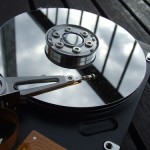
Yes, this is a remarkably boring topic because hard drives should just work. Like toilets. I shouldn’t have to think too much about them, however…
Special Collections here at Lafayette is participating in of our WordPress pilot by providing their students a place to write about their day-to-day work activities. One of the things their students are doing is creating videos about these daily tasks, such as how to create protective jackets for very old books and documents. The files to produce these videos are quite large, so Special Collections found a 500GB hard drive laying around (pretty cool, huh?). The downside is that the drive was formatted for Windows NTFS file structure, which Macs cannot write on, and since the students are doing all of their editing using iMovie ’08 we needed to figure out another option. At first I thought FAT 32 would work, but I did some digging and found that FAT 32 will not recognize files larger than 4GB, which could be a problem when working with video.
Since the students will likely be working on their movies exclusively in our Mac lab I created two partitions: one for Mac only formatting and one using FAT 32 for both PC and Mac. I figure the compressed videos could be moved over to the FAT 32 partition, assuming they remain under 4GB, while the project and raw video could be saved on the Mac partition.
I’m open for other suggestions.